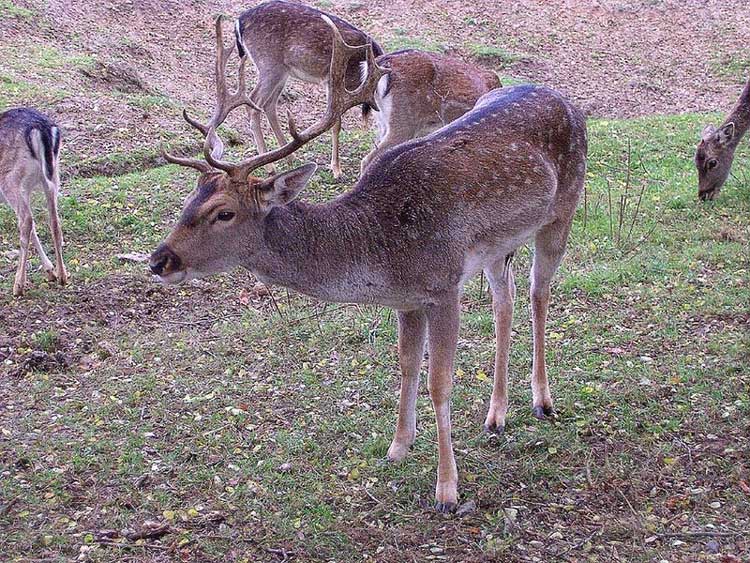Dama dama (*) Cladus: Eukaryota Name Dama dama (Linnaeus, 1758) References * Dama dama on Mammal Species of the World. Vernacular names The Fallow Deer (Dama dama) is a ruminant mammal belonging to the family Cervidae. The male is known as a buck, the female is a doe, and the young a fawn. Adult bucks are 140–160 cm long and 90–100 cm shoulder height, and 60–85 kg in weight; does are 130–150 cm long and 75–85 cm shoulder height, and 30–50 kg in weight. Fawns are born in spring at about 30 cm and weigh around 4.5 kg. The life span is around 12–16 years. All of the Fallow deer have white spots on their backs, and black tips at the ends of their tails. The species has great variations in the colour of their coats, with four main variants, "common", "menil", "melanistic" and "white" - a genuine colour variety, not albinistic.[2] The common coat variation has a brown coat with white mottles that are most pronounced in summer with a much darker coat in the winter. The white is the lightest colored, almost white; common and menil are darker, and melanistic is very dark, sometimes even black (easily confused with the Sika Deer). Most herds consist of the common coat variation, yet it is not rare to see animals of the menil, melanistic and white coat variations as well. Only bucks have antlers, which are broad and shovel-shaped. They are grazing animals; their preferred habitat is mixed woodland and open grassland. During the rut bucks will spread out and females move between them, at this time of year fallow deer are relatively ungrouped compared to the rest of the year when they try to stay together in groups of up to 150.
The Fallow Deer is a Eurasian deer[3] that was a native to most of Europe during the last Interglacial. In the Holocene, the distribution was restricted to the Middle East and possibly also parts of the Mediterranean region, while further southeast in western Asia was the home of a close relative, the Persian Fallow Deer (Dama mesopotamica), that is bigger and has larger antlers. In the Levant, Fallow Deer were an important source of meat in the Palaeolithic Kebaran-culture (17000-10000 BC), as is shown by animal bones from sites in northern Israel, but the numbers decreased in the following epi-Palaeolithic Natufian culture (10000-8500 BC), perhaps because of increased aridity and the decrease of wooded areas. Britain
Fallow deer are now widespread on the UK mainland and are present in most of England and Wales below a line drawn from the Wash to the Mersey. There have been long standing populations in the New Forest and the Forest of Dean and many of the other populations originated from park escapees. They are not quite so widespread in the northern parts of England but are present in most lowland areas and also in parts of Scotland, principally in the Tay valley and around Loch Lomond. According to the British Deer Society distribution survey 2007 they have enjoyed an increase in range since the previous survey in 2000 although the increase in range is not as spectacular as for some of the other deer species. A significant number of the fallow in the Forest of Dean and in Epping Forest are of the black variety. One particularly interesting population is that based in the Mortimer Forest on the England/Wales border where a significant part of the population have long hair with distinct ear tufts and longer body hair. Rhodes island The Rhodian population of Fallow Deer (D. d. dama) has been found to average smaller than those of central and northern Europe, though they are similarly coloured. In 2005 the Rhodian Fallow Deer was found to be genetically distinct from all other populations and to be of urgent conservation concern.[4] At the entrance to the harbour of Rhodes city, statues of a Fallow Deer buck and doe now grace the location where the Colossus of Rhodes once stood. United States In more recent times, Fallow Deer have also been introduced in parts of the United States. In some areas of central Georgia, wild Fallow Deer, not having any natural enemies, have increased to numbers that cause serious damage to young trees. Fallow Deer have also been introduced in Texas, along with many other exotic deer species, where they are often hunted on large game ranches. There is a herd of white fallow deer located near Argonne National Laboratories in central Illinois.[5] Historical herds One noted historical herd of fallow deer is located in the Ottenby Preserve in Öland, Sweden where Karl X Gustav erected a drystone wall some four kilometres long to enclose a royal fallow deer herd in the mid 17th century; the herd still exists as of 2006.[6] Another is Phoenix Park in Ireland where a herd of 400-450 fallow deer descend from the original herd introduced in the 1660s.[7] The Fallow Deer is easily tamed and is often kept semi-domesticated in parks today. Name The Latin word dāma or damma, used for roe deer, gazelles, and antelopes, lies at the root of the modern scientific name, and the German Damhirsch, French daim, Dutch damhert, and Italian daino. In Croatian and Serbian, the name for the fallow deer is jelen lopatar ("shovel deer"), due to the form of its antlers. The Hebrew name of the fallow deer, yahmur (יחמור), comes from the Aramaic language, where hamra (חמרא) means "red" or "brown".
Downe there comes a fallow Doe,
Notes 1. ^ Masseti, M. & Mertzanidou, D. (2008). Dama dama. In: IUCN 2008. IUCN Red List of Threatened Species. Downloaded on 8 April 2009. Database entry includes a brief justification of why this species is of least concern.
* FAO ANIMAL PRODUCTION AND HEALTH PAPER 27. (1982). Deer farming guidelines on practical aspects. ISBN 92-5-101137-0. Retrieved on 4 January 2008. Source: Wikipedia, Wikispecies: All text is available under the terms of the GNU Free Documentation License |
|


